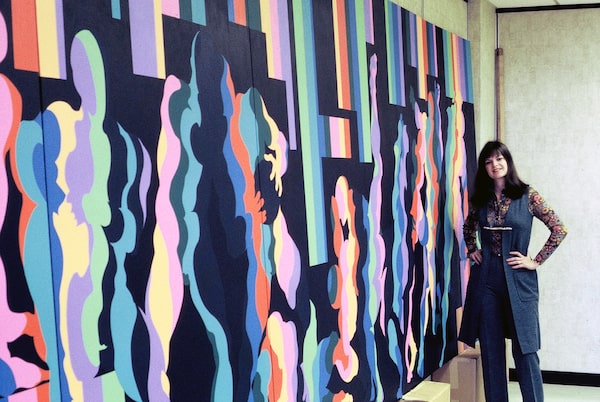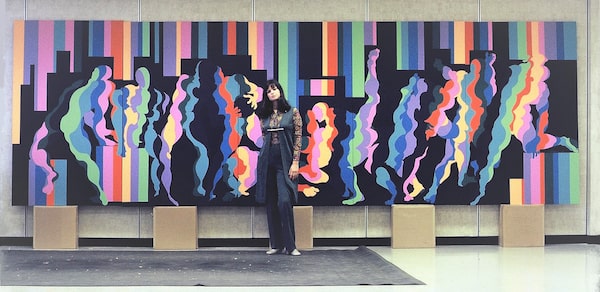Artist Lilian Broca produced a five-panel series that hung at the City Hall cafeteria in Vancouver, but for years has been unable to find them.Alana Paterson/The Globe and Mail
This is a mystery story about art.
In the 1970s, Vancouver buildings filled up with paintings, murals, mosaics, tapestries, and even statues as money flowed from the Pierre Trudeau government to a program meant to provide jobs to young boomers graduating from school and college into a country with high unemployment.
The money spurred projects as varied as thrift stores, arts magazines and music in parks. It was the foundation for many Vancouver institutions, from the Contemporary Art Gallery to the Vancouver Children’s Festival to the Vancouver East Cultural Centre.
Public art projects, in particular, benefitted, harnessing the “collaborative utopian spirit of the era,” wrote Reid Shier, a former curator at the CAG, in a 2003 brochure.
Newcomers like Liz Magor, Robert Davidson, Marian Penner Bancroft and Lilian Broca in Vancouver got money with almost no strings attached to produce art that was then displayed in government buildings, especially Vancouver civic buildings like City Hall and various libraries and community centres.
But some of it disappeared. Was it carted off and sold, destroyed, or left sitting in a back room somewhere? No one seems to know.
Ms. Broca wants to know what happened to some of her work.
She produced a five-panel series that hung at the City Hall cafeteria in the east wing, generating a news story at the time. Another large piece went into the main branch of the Vancouver Public Library at Burrard and Robson. Both works depicted abstract human figures entangled with each other, with the city-hall set depicting 11 figures – a mayor and 10 councillors.
But for years now, she hasn’t been able to find them. A few months ago, she discovered through a former city employee that at least some of the former city-hall panels were moved to a wall in a social-housing project in the Downtown Eastside. They then appeared to be painted over by a building manager who didn’t like them.
“It’s a shame,” says Ms. Broca, who recently had one of her murals, now at Kwantlen Polytechnic University, appraised at $55,000.


Lilian Broca with mural commissioned by the City of Vancouver in 1972.Supplied
“I tried very hard to find my murals over the years and got no satisfaction from anyone at the City Hall. They are responsible and I want answers.”
No one seems to have those answers.
“Our Special Collections team could find no record of this particular mural nor any documentation of where it might be,” wrote Marya Gadison on behalf of the library.
“They were able to find an article that confirms that Vancouver Public Library commissioned the mural and that it was painted at Douglas University, but we have no records of what happened to it after we moved from the Central Library’s Burrard St. location.”
Jonathan Baker, a now-retired municipal lawyer who was a Vancouver social planner who helped with the revolutionary move of public art from galleries and museums into civic facilities in the 1970s, recalls Ms. Broca’s city-hall project very well.
“Later on, it seemed to disappear. There was a lot of public art and a lot was taken or kept or stolen.”
He said that at the time, the city didn’t have any kind of record of what was being commissioned and where it went. “They were just collecting.”
Mr. Baker remembers that some prominent Vancouverites, like radio and then TV host Jack Webster, believed it was worthless. “He thought it was a bit of a joke.”
The Vancouver Art Gallery has five of Ms. Broca’s works – none of them the missing murals – but no information beyond that.
Matthew Hyland, the current executive director of the Contemporary Art Gallery, which was given the responsibility (though not the budget) for storing and managing the art in that earlier period, said he also has been unable to find a clear listing of everything or where pieces went.
“The sense I got was there were some great efforts to place works of art in public places but standard museum protocols were not in place,” he said.
Esther Rausenberg, an artist who has been a leading voice in the Vancouver arts community for years, said there was a huge amount done under the Trudeau program that has gone missing.
“Over the years, they disappeared.”
Eric Fredericksen, the current public-art program manager at Vancouver city hall, acknowledged in an interview that the city did not have a tracking system for its art before 1991. Things have been lost and there are some “orphans,” which is when no one quite knows where a piece came from.
Stories like Ms. Broca’s? “It happens but not every day.”
The main clue Ms. Broca has is what a man who worked for years at a city social-housing project told her after seeing her work at a recent show.
Jim Harrison had studied fine arts at the University of B.C. in the 1970s so he knew Ms. Broca’s style well. When he got a job in the late ‘80s at Oppenheimer Lodge, a 147-unit seniors project opposite Oppenheimer Park, he recognized her work hanging on the wall opposite the main-floor elevator. From his description of it, Ms. Broca believes it is one of the panels that had been at the city-hall cafeteria.
Mr. Harrison said in an interview with The Globe and Mail that, a couple of years before he retired in 2009, “a manager took a gallon of housepaint and a roller and whitewashed the whole thing.”
“I was absolutely shocked,” said Mr. Harrison.
He said when someone from the city phoned sometime later asking about it, trying to track it down, the manager “told them it was never there. He didn’t want to be embarrassed,” said Mr. Hamilton.
The wall where it hung is now a blank expanse of white.
The Globe tried to reach that manager, who is now longer listed as a Vancouver employee, but was not successful.
Mr. Fredericksen has no knowledge of that particular incident, but he said such a thing isn’t likely to happen again.
The city now maintains a close watch on all of its public art – 24 pieces, officially, with almost all of it currently on display except for a statue with a reference to Christopher Columbus that has been put in storage because of threats from activists that it would be defaced. (The Mungo Martin totem pole at Kits Point is not on display because it is being restored.)
The city’s public-art team is also the steward for work that the city doesn’t own, art that is the result of required contributions from developers, such as the spinning chandelier under the Granville Bridge that is the responsibility of of developer Ian Gillespie as part of the Vancouver House project that he built.
The team also takes care of not just art commissioned specifically for the city but work done by anonymous or non-anonymous locals that appear in the community.
But there is still more art that the city has no jurisdiction over.
“What’s interesting is how much happens in Vancouver that’s not fully accounted for,” Mr. Fredericksen said.
That includes the picket fence at Sahali Park at 8th and Fraser in east Vancouver, where someone carved faces and other designs into the tops of the fenceposts. Or the artwork that has been done by a local along the Arbutus Greenway.
“We’re not going to take it on as part of the collection. But if they run a new route there, I can advocate for it. We included it in the art plan.”
What he can’t do is find Ms. Broca’s work.
Which she can hardly believe, even now. “I wonder that such a thing is possible.”